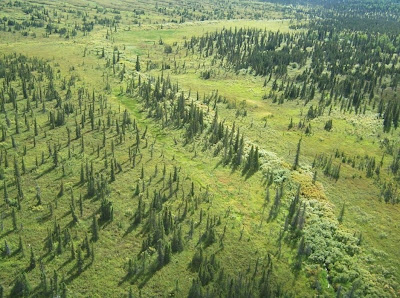Chefornak is a small coastal town in Alaska's subarctic tundra territory, on the south bank of the Kinia River, an arm of the Bering Sea.
Coordinates: 60°9′N, 164°16′W
[ more than 700 km south of the Arctic Circle ]
Population: ~ 480
Chefornak is a traditional Yup'ik Eskimo community; many of the villagers live a subsistence lifestyle, basically traditional hunter-gatherer activities. They rely mainly on halibut, salmon and herring, rabbits and birds, but in recent years Yup'ik art is a growing source of income.
On the vast expanse of tundra, Chefornak is but a cluster of plywood houses, a post office, a school, a church, all connected by wooden boardwalks.
A wooden boardwalk runs through the village, from the school at one end to a church at the other, connecting some two dozen houses.
Some 'Public Watering Points' are placed along the boardwalk. Clean water is one of the main problems in town.
The Kinia River (Urrsukvaaq) and its many tributaries are vital to the people of the village, allowing water travel and areas for hunting and fishing, but on the other hand they cause frequent floods implying undesired dislocation.
School
Probably the best building in town, it's a modern and comfortable school made to improve standards of life, but respecting the native Yup'ik lifestyle.
Post Office
Community Service Center
St. Catherine of Siena Catholic Church
Artists of Chefornak
Jane Wiseman gathers a variety of grasses along the banks of the rivers near her village, to craft exquisite finely coiled grass baskets:
Jane Wiseman hand treats and dyes the grasses and weaves baskets, bowls and trays.
Mary Jane Joseph, Grass Basket
Pauline Jimmy, a coiled grass basket
Joan Tenenbaum, Raven in flight
Joan Tenenbaum, pendant
A popular activity in Chefornak is Yup'ik dancing. The high school has a dance team that visits other villages for feasts and festivals.
Traditional dance.
Women use dance fans made of woven grass and caribou feathers, while men use a ring-style dance fan made of wood and feathers.
A Yup'ik man dance fan.
Yukon Delta Wildlife reserve
Subarctic, far below the arctic circle, this region has tundra as well as forest and mountain landscape; but nonetheless the critical treeline is quite strongly marked here, the forest and the tundra clearly bounded.
Here the treeline is almost north-south oriented, parallel to the coastline.
As we approach the coast, the landscape changes to vast flat and grassy wetlands; thousands of canals and ponds among green patches.
Treeless coastal sedge meadows
Strong, dense grass
A maze of lowland marshes.


.JPG)






















